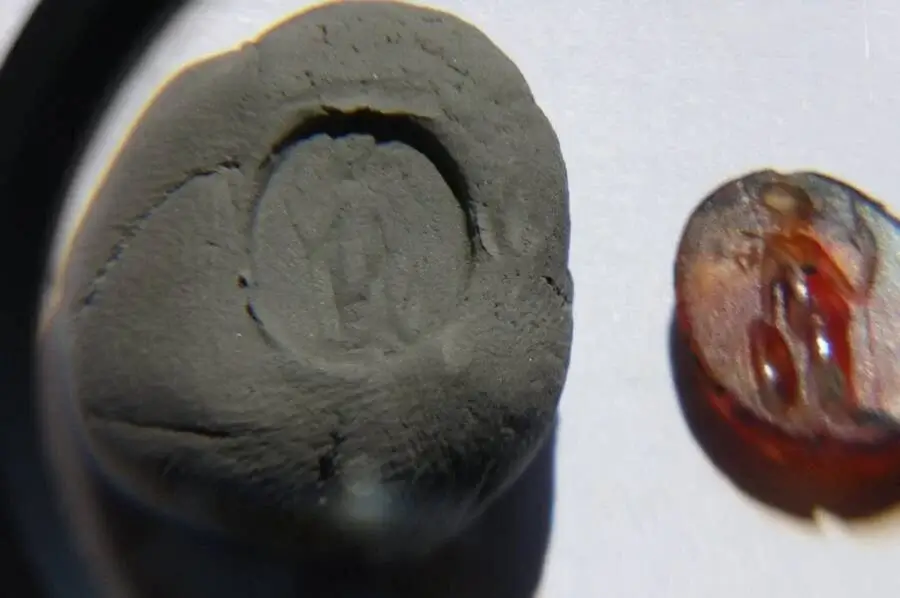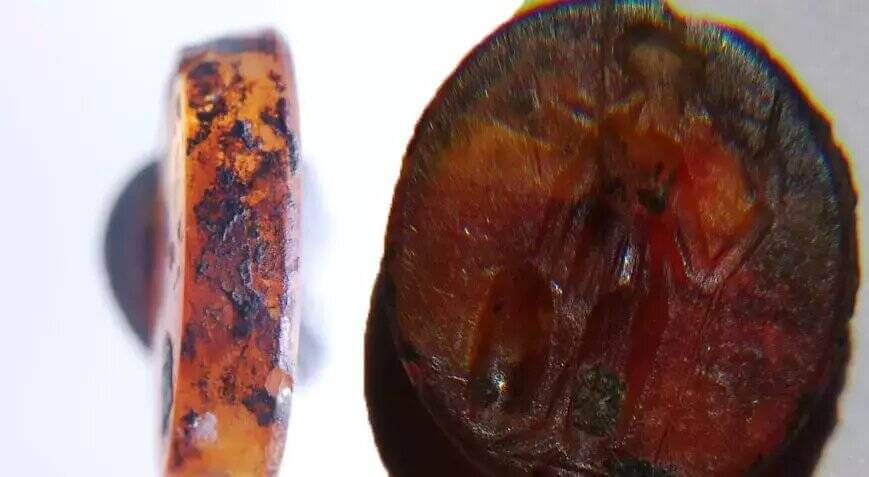The Roman Ringstone ,archaeology often feels like time travel, and in the ancient city of Assos, Türkiye, that journey just got a little more exciting. A team of archaeologists recently uncovered a 1,700-year-old Roman ringstone engraved with the image of Athena, the goddess of wisdom and war. This discovery sheds new light on the rich history of a city that once thrived under Greek and Roman rule, revealing yet another layer of its storied past.
The Discovery: A Roman Seal Fit for a Goddess
Imagine you’re living in the 2nd or 3rd century C.E. You’re someone important—perhaps a city official or a wealthy merchant. Instead of signing papers, you seal documents with an ornate ringstone, marking them with a symbol of your status and power. Fast forward nearly two millennia, and that very seal, featuring none other than Athena, has been found in the ruins of Assos.
Archaeologists believe this ringstone, discovered during recent excavations, was likely used as a seal by a high-ranking individual during the Roman Imperial Period. The intricate carving of Athena, who was the protector of Assos, speaks to the city’s reverence for this powerful deity. Professor Nurettin Arslan, head of the excavation, described the discovery as a significant find, noting that such stones were common in the Roman era but were also used before and after that time.
Arslan and his team from Çanakkale Onsekiz Mart University have been meticulously working in Assos for decades, uncovering artifacts that help paint a clearer picture of life in this ancient city. The ringstone, carved with a standing image of Athena, is just one of many finds that continue to tell the tale of Assos’ glory days.

Athena: Goddess of Wisdom, War, and… Seals?
Athena, often associated with wisdom, war strategy, and craftsmanship, was the chief goddess of Assos. It’s no surprise that a symbol of her was chosen for such a significant item as a seal. This small piece of stone likely carried immense meaning, not just as a tool but as a mark of the individual’s status and connection to the divine.
Archaeologists believe that the ringstone dates back to the Roman era, around 1,700 years ago. However, its purpose as a seal adds an extra layer of historical intrigue. Much like today’s signatures or personal stamps, seals in the Roman period identified the sender or author of important documents. So, whoever owned this ringstone likely wielded considerable influence in Assos during its Roman heyday.
The Ancient City of Assos: A Polis Frozen in Time
Assos, located in the Ayvacık district of Çanakkale, Türkiye, has a history that stretches back thousands of years. First settled during the Bronze Age, the city became a significant center under both Greek and Roman rule. Aristotle himself even lived in Assos at one point, making it a hub for intellectual thought.
The city was founded by settlers from the nearby island of Lesbos in the 7th century B.C.E. and flourished under the kingdom of Lydia before falling under Persian control. Over time, it was absorbed into Alexander the Great’s empire and later the Roman Empire, where it enjoyed its golden age. Despite its decline over the centuries, Assos remains one of the best-preserved examples of a polis city-state.
For archaeologists, Assos is a treasure trove. Every year, new discoveries are made, ranging from ancient structures to everyday objects that offer a glimpse into the lives of its inhabitants. Recently, alongside the ringstone, researchers unearthed a Byzantine-era complex that may have functioned as a guesthouse or inn. This multi-room structure, located near the city’s western gate, provides valuable insights into the city’s layout and social structure during Byzantine times.
The Importance of Seals in the Roman Era
Seals were a big deal in ancient times. Think of them as the ultimate power move—a way for the elite to authenticate documents and make statements without uttering a word. Roman seals, often engraved on rings or small stones like the one found in Assos, were used to mark official correspondence or sign contracts. Much like a modern-day signature, a seal was unique to its owner and could instantly command respect.
But unlike signatures, these seals carried symbolic meaning. In this case, the image of Athena on the ringstone wasn’t just decorative; it represented wisdom, strategic thinking, and protection—qualities the owner likely wanted to convey.

A Glimpse into the Past: What the Ringstone Tells Us
Finding this Roman ringstone isn’t just about adding another artifact to a museum collection. It offers us a tangible connection to the people who once walked the streets of Assos. This small object, with its intricate engraving of Athena, tells us about the city’s culture, its reverence for the goddess, and the lives of the people who lived there.
Archaeology is like piecing together a puzzle, and with every find, we get a little closer to understanding how ancient civilizations functioned. The ringstone from Assos, along with the Byzantine complex and other recent discoveries, helps fill in those gaps, providing a clearer picture of a city that once stood as a beacon of culture and power in the ancient world.
Why This Matters Today
Artifacts like the Athena ringstone aren’t just relics of the past; they are windows into our shared human history. They show us how people lived, what they valued, and the symbols of power they revered. And in a world where much of our history can feel distant, tangible finds like these bring the past to life in vivid detail.
For those of us fascinated by history, the discovery of this 1,700-year-old ringstone is a reminder of how much there is still to learn. It’s a reminder that the past is always present, just waiting to be uncovered.
Explore the Mysteries of Assos
Feeling inspired to learn more about ancient civilizations and the hidden treasures they left behind? Keep an eye on ongoing archaeological discoveries in Assos and other historical sites worldwide. Who knows—perhaps the next great find is just around the corner. Share your thoughts or theories about this discovery with us, and let’s keep the conversation going!

